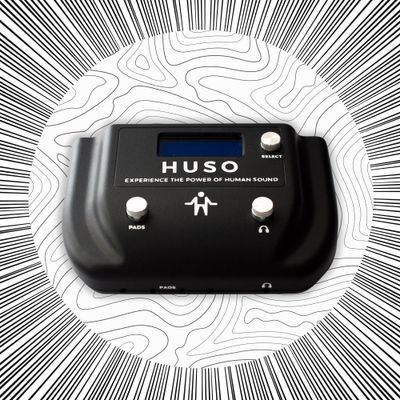
When I was in college, I fulfilled my prerequisite for art credit in the form of a History of Music class. I found it excruciatingly boring, but it did give me something: Gregorian chants and an unexpected appreciation for them. At the time, I was experiencing peak pre-graduation anxiety, not yet on medication, and desperate for soothing, repetitive entertainment — in the form of Sex and the City DVDs watched on repeat, mostly, and then in the form of my “Gregorian chants” station on Pandora. I was no longer religious by then, but I grew up Catholic and may be predisposed to enjoy the sound of men half-singing unintelligibly. Their voices, barely accessorized with the occasional gong, calmed me and made me feel connected to something greater than myself.
It was this early experience with Gregorian chants that informed my hopes and dreams for the HUSO, a sound-therapy device that showed up on my desk a few months back. Large, plastic, and shaped like an old N64 game cartridge, the HUSO (an acronym for HUman SOund) is not unlike an mp3 player that plays one of ten built-in files, named for the state they’re meant to put you in (“Relax,” “Clarity,” “Release,” etc.). Only it’s not an mp3 player, says the company, and is instead a “patented technology consisting of human sound that has been modulated in a proprietary way by combining specific frequencies, harmonics, and waveforms capable of restoring balance and wellbeing in the brain and body.” What this means exactly, I’m not sure, but what it sounds like is a group of humans not quite singing and not quite humming: intoning, maybe, and run through a distorter, so that it hardly sounds human at all. According to the website, listening to these sounds will give you better rest, better health, better performance, and less stress.
All this can be yours for $469 ($499 with headphones).
Proprietary though it may be, you can listen to a 20-second sample of “Expand” (my favorite, incidentally) on its website, though I find this snippet a bit misleading. Listening on my computer, I hear something like angels floating in harmony in the beautiful cosmos. Listening to the same program on my HUSO, I hear one really high-pitched note in my left ear over a duller, imposing drone beneath it. When I checked the product’s FAQ for explanation, I found the following, fitting inquiry: “Why am I having some irritation during or after a session?” My annoyance is a detox symptom, the site tells me, though detoxing from what isn’t clear — electromagnetic frequency is referenced, so maybe the HUSO is meant to turn all your body’s bad sound waves into good ones? In any case, the implication is that if I don’t like a certain sound, that means it’s working. Which is annoying.
Over the course of an afternoon a week before my wedding — the perfect time to heal myself with sound, I thought — I sampled several HUSO programs. Lying prone on my couch, strapped into the vibrating elastic bands meant to stimulate major acupuncture meridians (and thoroughly frightening my dog), I closed my eyes, and sought to become “Calm.” When “Calm” sounded a lot like impending alien abduction, I tried “Comfort.” When “Comfort” sounded like the scene in an action movie where the good guy is tiptoeing down the hall to open a door you know the bad guy isn’t behind, I tried “Focus,” which reminded me of the X-Files episode where the guy starts seeing, like, “MURDER!” and “KILL THEM!” messages on TV screens and calculators and stuff.
Because I’d been informed my irritation was actually good, and because I was only listening for a few minutes at a time, I wondered if I was being fair. Music has been shown to reduce stress, so the purported science behind HUSO doesn’t seem too out of bounds. As Ted Zanto, assistant professor of neurology at the University of California, San Francisco, tells me, “Music improves health and wellbeing. Relaxation in general improves health and wellbeing. I wouldn’t be surprised if [HUSO] does help improve wellness.” As to whether HUSO does what it claims, to any substantial degree, Zanto says the evidence just isn’t there — without a controlled study comparing HUSO to other music, or even to silence (which is also relaxing, Zanto says), we can’t be confident that it can meaningfully reduce stress.
As for HUSO’s claims that its technology provides optimal, “lossless” sound quality — unlike mp3 files — Zanto is similarly skeptical. “It’s unclear whether you need to spend $500 on a product when you could get the same thing from listening to a YouTube video of relaxing music,” he says.
Because the technology aspect is totally opaque to me, I enlisted the services of Chris Kyriakakis, a professor of electrical engineering at the University of Southern California, who pored over the HUSO website while on the phone with me. Kyriakakis agrees that music, broadly, is relaxing, but he adds that what kind of music is very person-dependent. “We would probably agree that AC/DC wouldn’t be relaxing, but there are all kinds of music used for relaxation by professional psychologists, so the claim that this is something unique and attuned to human frequencies is just marketing,” he says.
Kyriakakis went on to ask me several descriptive questions about the HUSO device, which I answered to the best of my ability. Admittedly, he didn’t handle one in person, but, he says, “it looks, frankly, like a very old-school, cheap, Chinese-made mp3 player.” Noting the portion of the FAQ that explains why the HUSO isn’t wireless (the site claims cords “allow us to shield you from as much exposure to WIFI and harmful EMFs as possible”), Kyriakakis says this is a way to make a bug seem like a feature. “Radiation from wireless anything, whether it’s Bluetooth or Wi-Fi, doesn’t affect human tissue,” he says. “They didn’t want to pay for wireless, because it costs money, so they say it’s ‘to avoid negative energy.’ Oh, come on.”
At this point I grew desperate for Kyriakakis to weigh in on everything/everyone in my life, but I limited myself to asking what he thought about HUSO’s statement that they can’t predict results because every customer’s energy is “fluid” and their “frequency determined by so many factors.”
“I have no idea what that means,” Kyriakakis says. “Humans don’t have frequencies.” While humans can produce frequencies by making sound, he says, the human body does not, inherently, operate or “vibrate” at any given “frequency.” To HUSO’s claims that its proprietary sound can, in some way, alter our cells, Kyriakakis is equally, delightfully dismissive. “There’s no sound that affects cells,” he tells me. “ It has to be high-powered lasers, because the oscillations needed to affect cells are very high frequency, and audible sound is nowhere near there.” High! Powered!!! Lasers!!!!!
Anyway, perhaps it’s no surprise to you that it’s a bad idea to spend $500 on a box that plays ten long, unpleasant songs. But I admit I held out hope. Something about the equipment’s heft made the venture feel noble, and scientific — like I had some unique need met only by expensive, futuristic treatment. Taking a pill can be so boring, so … terrestrial. Strapping myself into the HUSO felt as close as I’ll ever get to outer space. It also reminded me to look up Gregorian-chant playlists on the internet, which was a nice way to kill half an hour.





